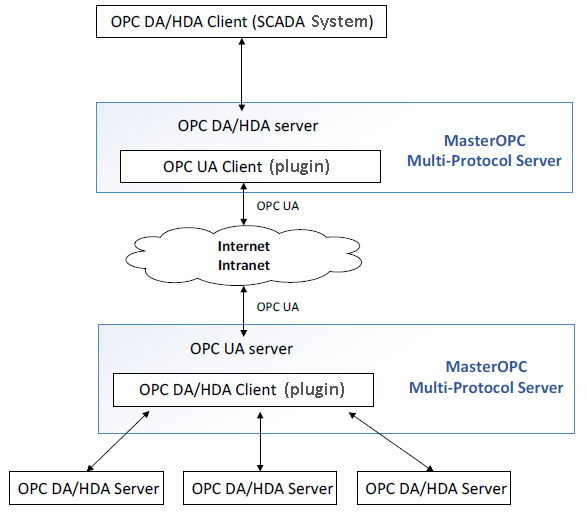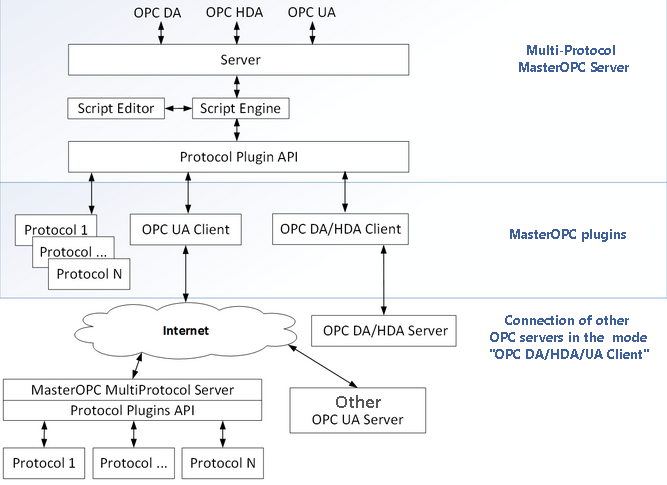Main Characteristics
Multi-Protocol MasterOPC Server is a family of DA/HDA/UA OPC servers for exchange with devices via various of protocols.
The base server of the family, Multi-Protocol SDK MasterOPC Server, is a DA/HDA OPC server supplied with an open interface to plug communication drivers to exchange with devices. The server is supplied with SDK and intended to configure and test communication drivers developed as server plugins (see Plugin Development Rules and Plugin Plugging Rules ). Multi-Protocol SDK MasterOPC Server contains examples of plugins (mpsplugin-dcon.spl and mpsplugin-simulator.spl).
Multi-Protocol MasterOPC Server contains OPC UA server and OPC UA client .
![]() The base difference of OPC UA from OPC is a rejection of the Microsoft technologies COM and DCOM, and transition to SOA (Service Oriented Architecture). In other words, there is no need to configure COM/DCOM when configuring interaction "UA clients – UA servers".
The base difference of OPC UA from OPC is a rejection of the Microsoft technologies COM and DCOM, and transition to SOA (Service Oriented Architecture). In other words, there is no need to configure COM/DCOM when configuring interaction "UA clients – UA servers".
Multi-Protocol MasterOPC Server contains IEC104 server and OPC DA client as well.
The next diagram shows typical use of DA client, UA server and UA client of Multi-Protocol MasterOPC.

Using Multi-Protocol SDK MasterOPC Server, series of OPC servers can be produced for different protocols (for instance, SNMP). Names of such products include the protocol name (for instance, Multi-Protocol MasterOPC Server. SNMP or, shortly, MPS.SNMP). Such an OPC server differs from the parent: 1) there is no SDK; 2) there is no ability to plug any other plugin. All other features (the built-in programming language Lua, OPC properties, etc.) are remained.
Thus, Multi-Protocol MasterOPC Server provides access of OPC clients to tags of a device with any interface/protocol.
As an OPC client, any SCADA system can act (if it supports the OPC standard): MasterSCADA ( http://www.masterscada.ru ), InTouch, Genesis and others.
Below is a structure of Multi-Protocol MasterOPC Server:

As an OPC server, Multi-Protocol MasterOPC Server supports
![]() The standard OPC Data Access Custom 2.00
The standard OPC Data Access Custom 2.00
![]() The specification OPC DA 2.05a
The specification OPC DA 2.05a
![]() The specification OPC HDA
The specification OPC HDA
![]() The specification OPC UA (Unified Architecture).
The specification OPC UA (Unified Architecture).
OPC standards and specifications are available at the official site of OPC Foundation ( http://www.opcfoundation.org ).
Multi-Protocol MasterOPC Server is supplied with the built-in programming language Lua version 5.1.4 (the official Lua site is http://www.lua.org/ ). The section Lua 5.1 Reference Manual of the current help contains a copy of the description available at http://www.lua.org/manual/5.1/ , as well as description of API functions that provide interaction with server objects (see Multi-Protocol MasterOPC Server API).
LuaSQLite3 ( http://lua.sqlite.org/index.cgi/index ) is built into Multi-Protocol MasterOPC Server in order to provide interaction with SQLite databases ( http://www.sqlite.org/ ). The version 8 of lsqlite3 (known as devel-0.8) is supported. The section LuaSQLite3 Reference Manual of the current help contains a copy of the description available at http://lua.sqlite.org/index.cgi/doc/tip/doc/lsqlite3.wiki .
The built-in language and API functions provide the following benefits:
![]() Data processing
Data processing
![]() Configuration of gateways to transfer data from one port to another, or from one protocol to another
Configuration of gateways to transfer data from one port to another, or from one protocol to another
![]() Operations with server objects (see Multi-Protocol MasterOPC Server API)
Operations with server objects (see Multi-Protocol MasterOPC Server API)
![]() Interaction with SQLite databases.
Interaction with SQLite databases.